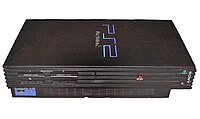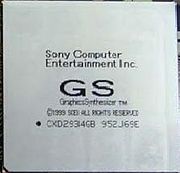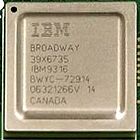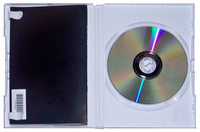The PlayStation 2 (abbreviated "PS2") is Sony's second video game console, the successor to the successful PlayStation and the predecessor to the PlayStation 3 as part of the PlayStation series. Its development was announced in March 1999 and it was released a year later in Japan.
The PS2 is part of the sixth generation era, and is the best-selling console to date,[4][5] having reached over 140 million units in sales by mid-2008.[2][6][7]
History
Only a few million people had obtained consoles by the end of 2000 due to manufacturing delays.[8] After its release, it was difficult to find PS2 units on retailer shelves.[9] Another option was purchasing the console online through auction websites such as eBay, where people paid over one thousand dollars for a PS2.[10] The PS2 initially sold well partly on the basis of the strength of the PlayStation brand and the console's backward compatibility, selling over 980,000 units by March 5, 2000, one day after launch, in Japan.[11] This allowed the PS2 to tap the large install base established by the PlayStation — another major selling point over the competition. Later, Sony gained momentum with new development kits for game developers and more PS2 units for consumers.
A notable piece of advertising for the PS2 launch was accompanied by the popular "PS9" television commercial. 9 was to be the epitome of development, toward which the PS2 was the next step. The ad also prestaged the development of a portable PlayStation[citation needed] (first released in Japan on December 12, 2004).
Many analysts predicted a close three-way matchup between the PS2 and competitors Microsoft's Xbox and the Nintendo GameCube (GameCube being the cheapest of the three consoles and had an open market of games); however, the release of several blockbuster games during the 2001 holiday season maintained sales momentum and held off the PS2's rivals.[12]
Although Sony, unlike Sega with its Dreamcast, placed little emphasis on online gaming during its first years[citation needed], that changed upon the launch of the online-capable Xbox. Sony adapted in late 2002 to compete with Microsoft, with several online first–party titles released alongside it, such as SOCOM: U.S. Navy SEALs to demonstrate its active support for Internet play. Sony also advertised heavily, and its online model had the support of Electronic Arts. Although Sony and Nintendo both started out late, and although both followed a decentralized model of online gaming where the responsibility is up to the developer to provide the servers, Sony's attempt made online gaming a major selling point of the PS2.
In September 2004, in time for the launch of Grand Theft Auto: San Andreas, Sony revealed a new, slimmer PS2 (see Hardware revisions). In preparation for the launch of a new, slimmer PS2 model (SCPH-70000; also known unofficially as the "PStwo"), Sony stopped making the older PS2 model (SCPH-5000x) during the summer of 2004 to let the distribution channel empty its stock of the units. After an apparent manufacturing issue caused some initial slowdown in producing the new unit, Sony reportedly underestimated demand, caused in part by shortages between the time the old units were cleared out and the new units were ready. The issue was compounded in Britain when a Russian oil tanker became stuck in the Suez Canal, blocking a ship from China carrying PS2s bound for the UK. During one week in November, British sales totaled 6,000 units — compared to 70,000 units a few weeks prior.[13] There were shortages in more than 1700 stores in North America on the day before Christmas.[14]
On November 29, 2005, the PS2 became the fastest game console to reach 100 million units shipped, accomplishing the feat within 5 years and 9 months from its launch. This achievement occurred faster than its predecessor, the PlayStation, which took 9 years and 6 months to reach the same benchmark.[15] The console still continues to be popular, as games are still released for it and the other systems in its generation have died out.
[edit] Hardware and software compatibility

- See also: List of PlayStation 2 games, List of PlayStation games incompatible with PlayStation 2, List of PlayStation 2 CD-ROM games, List of PlayStation 2 DVD-9 games, List of HD Enhanced PS2 games, and Chronology of PlayStation 2 games
In addition to PS2 software, the PS2 can read both CDs and DVDs and is backward compatible with PlayStation games. The ability to play DVD movies was an added incentive for consumers to be able to justify purchasing the PS2 (the MSRP was US$300 in October 2000). The PS2 also supports PlayStation memory cards (for PlayStation game saves only) and controllers, although the memory cards only work with PS1 games and the controllers may not support all functions (such as analog buttons) for PS2 games.
The PS2's DualShock 2 controller is essentially an upgraded PlayStation DualShock; analog face, shoulder and D-pad buttons replaced the digital buttons of the original. Like its predecessor, the DualShock 2 controller has force feedback, which is commonly called the "vibration" function. The standard PlayStation 2 memory card has an 8MB capacity and uses Sony's MagicGate encryption. This requirement prevented the production of memory cards by third parties who did not purchase a license for the MagicGate encryption. The memory card can store PlayStation game saves, but PlayStation games cannot read from or write to the card - it can only be used as a backup.
The console also features USB and IEEE 1394 expansion ports. Compatibility with USB and IEEE 1394 devices is dependent on the software supporting the device. For example, the PS2 BIOS will not boot an ISO image from a USB flash drive or operate a USB printer, as the machine's operating system does not include this functionality. By contrast, Gran Turismo 4 is programmed to save screenshots to a USB mass storage device and print images on certain USB printers. A PlayStation 2 HDD can be installed in an expansion bay on the back of the console, with some exceptions (see Hardware revisions below).
[edit] Online
- See also: List of PlayStation 2 network games
With the purchase of a separate unit called the Network Adapter (which is built into the slimline model), some PS2 games support online multiplayer. Instead of having a unified, subscription-based online service like Xbox Live, online multiplayer on the PS2 is split between publishers and run on third-party servers. Most recent PS2 online games have been developed to exclusively support broadband Internet access. Xbox Live similarly requires a broadband Internet connection.
All online PS2 games released in and after 2003 are protected by the Dynamic Network Authentication System (DNAS). The purpose of this system is to prevent piracy and online cheating. DNAS will prevent games from being played online if they are determined to be pirated copies or if they have been modified. Recently, however, methods have been developed to get around this protection by modifying key files in the pirated game.
Also, some unofficial hacks have been made on the PS2 software allowing it to be used as a fully-functional web browser or messenger when connecting to a certain network. The PS2 can also run Linux.
[edit] Hardware revisions
The PS2 has undergone many revisions, some only of internal construction and others involving substantial external changes. These are colloquially known among PS2 hardware hackers as V0, V1, V2, etc., up to V15b[16] (as of 2008).
The PS2 is primarily differentiated between models featuring the original case design and "slimline" models, which were introduced at the end of 2004.
[edit] Original case design
Three of the original PS2 launch models (SCPH-10000, SCPH-15000, and SCPH-18000) were only sold in Japan, and lacked the expansion bay (Dev9) of current PS2 models. These models included a PCMCIA slot instead of the Dev9 port of newer models. A PCMCIA-to-Dev9 adapter was later made available for these models[citation needed]. SCPH-10000 and SCPH-15000 did not have a built-in DVD movie playback and instead relied on encrypted playback software that was copied to a memory card from an included CD-ROM (normally, the PS2 will only execute encrypted software from its memory card, but see PS2 Independence Exploit). V3 had a substantially different internal structure from the subsequent revisions, featuring several interconnected printed circuit boards. As of V4 everything was unified into one board, except the power supply. V5 introduced minor internal changes, and the only difference between V6 (sometimes called V5.1) and V5 is the orientation of the Power/Reset switch board connector, which was reversed to prevent the use of no-solder modchips. V7 and V8 included only minor revisions to V6.
Assembly of the PS2 moved to the People's Republic of China during the development of V9 (model numbers SCPH-50000 and SCPH-50001). The upgraded console added an infrared port for the optional DVD remote control, removed the IEEE 1394 port, added the capability to read DVD-RW and DVD+RW discs, added progressive-scan output of DVD movies, and added a quieter fan. V10 and V11 were only minor revisions to V9.
The PS2 standard color is matte black. Several different variations in color have been produced in different quantities and regions, including ceramic white, light yellow, metallic blue (aqua), metallic silver, navy (star blue), opaque blue (astral blue), opaque black (midnight black), pearl white, Sakura purple, satin gold, satin silver, snow white, super red, and transparent blue (ocean blue).[17][18][19][20]
The small PlayStation logo on the front of the disc tray could be rotated ninety degrees clockwise, in order for the logo to be the right way up in both vertical and horizontal console orientations.
[edit] Slimline
In September 2004, Sony unveiled its third major hardware revision (V12, model number SCPH-70000). Available in November 2004, it is smaller, thinner, and quieter than the older versions and includes a built-in Ethernet port (in some markets it also has an integrated modem). Due to its thinner profile, it does not contain the 3.5" expansion bay and therefore does not support the internal hard disk drive. It also lacks an internal power supply, similar to the GameCube, and has a modified MultiTap expansion. The removal of the expansion bay has been criticized as a limitation due to the existence of titles such as Final Fantasy XI, which require the use of the HDD. The official PS2 Linux also requires an expansion bay to function. Currently only the modified MultiTap is sold in stores, meaning that owners of older PS2s must find a used or non-Sony MultiTap in order to have 4 or 8 players during a single game. Third-party connectors can be soldered into the unit giving hard drive support, however IDE connections were completely removed in the V14 revision, thereby eliminating this option.

There are some disputes on the numbering for this PS2 version,[citation needed] since there are actually two sub-versions of the SCPH-70000.[21] One of them includes the old EE and GS chips, and the other contains the newer unified EE+GS chip, but otherwise they are identical. Since the V12 version had already been established for this model, there were some disputes regarding these sub-versions. Two propositions were to name the old model (with separate EE and GS chips) V11.5 and the newer model V12, and to name the old model V12 and the newer model V13. Currently, most people use V12 for both models, or V12 for the old model and V13 for the newer one.
The V12 model was first released in black, but a silver edition is available in the United Kingdom, Germany, Australia, United Arab Emirates and other GCC Countries,France, Italy, South Africa, and most recently, North America. It is unknown whether or not this will follow the color schemes of the older model, although a limited edition Pink PS2 has become available since March 2007.
V12 (or V13) was succeeded by V14 (SCPH-75001 and SCPH-75002), which contains integrated EE and GS chips, and different ASICs compared to previous revisions, with some chips having a copyright date of 2005, compared to 2000 or 2001 for earlier models. It also has a different lens and some compatibility issues with a different number of PlayStation games and even some PS2 games.
In the beginning of 2005 it was found that some black slimline console power transformers bought between November and December 2004 were faulty and could overheat. The units were recalled by Sony, with the company supplying a replacement model made in 2005.
Later hardware revisions had better compatibility with PlayStation games (Metal Gear Solid: VR Missions operates on most silver models); however, the new Japanese slim models have more issues with playing PlayStation games than the first PS2 revisions.[citation needed]
In 2006, Sony released the latest hardware revisions (V15, model numbers SCPH-77001a and SCPH-77001b). It was first released in Japan on September 15, 2006, including the Silver limited edition. After its release in Japan, it was then released in North America, Europe, and other parts of the world. The new revision uses an integrated, unified EE+GS chip, a redesigned ASIC, a different laser lens, an updated BIOS, and updated drivers.
In July of 2007, Sony started shipping a revision of the slimline PlayStation 2 (SCPH-79000) featuring a reduced weight of 600 grams compared to 900 grams of the SCPH-77001, achieved through a reduction in parts. The unit also uses a smaller motherboard as well as a custom ASIC which houses the Emotion Engine, Graphics Synthesizer, and the RDRAM. The AC adaptor's weight was also reduced to 250 grams from the 350 grams in the previous revision.[22]
Another refinement of the slimline PlayStation 2 (SCPH-90000) was released in Japan on November 22, 2007, with an overhauled internal design that incorporates the power supply into the console itself, with a further reduced total weight of 720 grams.[23]
[edit] PSX
Sony also manufactered a consumer device called the PSX that can be used as a digital video recorder and DVD burner in addition to playing PS2 games. The device, which was only released in Japan, was poorly received, with some major features absent from the first revisions of the hardware, and has thus far experienced very weak sales in Japan, in spite of major price drops.[24] The machine's future continues to be uncertain, with North American and European launches considered to be distant, if at all, especially since the release of the PlayStation 3.
[edit] Accessories
The PlayStation 2's DualShock 2 controller is largely identical to the PlayStation's DualShock, with the same basic functionality; however, it includes analog pressure sensitivity on the face, shoulder and D-pad buttons, is lighter and includes two more levels of vibration. The L2 and R2 buttons are also significantly larger. The fact that the design did not change pleased some consumers who were already used to the DualShock controller.[citation needed]

Optional hardware includes DualShock or DualShock 2 controllers, a PS2 DVD remote control, an internal or external HDD, a network adapter, horizontal and vertical stands, PlayStation or PS2 memory cards, light guns (GunCon), fishing rod and reel controllers. Also available are various cables and interconnects, including the Multitap for PlayStation or PS2, S-Video, RGB, SCART, VGA (for progressive scan games and PS2 Linux only), component and composite video cables, an RF modulator, a USB camera (EyeToy), dance pads for Dance Dance Revolution, In the Groove, and Pump It Up titles, Konami microphones for use with the Karaoke Revolution games, dual microphones (sold with and used exclusively for SingStar games), various "guitar" controllers (for the Guitar Freaks series and Guitar Hero series), the drum set controller (sold in a box set (or by itself) with a "guitar" controller and a USB microphone for use with Rock Band), Onimusha 3 katana controller, Resident Evil 4 chainsaw controller, a USB keyboard and mouse, and a headset. Unlike the PlayStation, which required the use of an official Sony PlayStation mouse to play mouse-compatible games, the few PS2 games with mouse support work with standard PC-compatible USB mice. Early versions of the PS2 could be networked via an iLink port, though this had little game support and was dropped. The original PS2 multitap cannot be plugged into the newer slim models (as the multitap connects to the memory card slot as well as the controller slot and the memory card slot on the slimline is shallower). New slim-design multitaps are manufactured for these models, however third-party adapters also exist to permit original multitaps to be used. Some third party manufacturers have created devices that allow disabled people to access the PS2 through ordinary switches etc. One such device is the PS2-SAP from LEPMIS.
[edit] Homebrew development
Sony released a version of the Linux operating system for the PS2 in a package that also includes a keyboard, mouse, Ethernet adapter and HDD. Currently, Sony's online store states that the Linux kit is no longer for sale in North America. However as of July 2005, the European version was still available. The kit boots by installing a proprietary interface, the run-time environment, which is on a region-coded DVD, so the European and North America kits only work with a PS2 from their respective regions.
In Europe and Australia, the PS2 comes with a free Yabasic interpreter on the bundled demo disc. This allows simple programs to be created for the PS2 by the end-user. This was included in a failed attempt to circumvent a UK tax by defining the console as a "computer" if it contained certain software.[citation needed]
A port of the NetBSD project and BlackRhino GNU/Linux, an alternative Debian-based distribution, are also available for the PS2.
Using homebrew programs (e.g. 'SMS Media Player'[25]) it is possible to listen to various audio file formats (MP3, Ogg, AAC, FLAC, AC3), and watch various video formats (MPEG1, MPEG2, MPEG4-ASP in AVI Container) using the console. Media can be played from any device connected to the console i.e. external USB/Firewire thumb drive/hard disk (FAT32 only), the internal hard disk on early revision consoles, optical CD-R(W)/DVD±R(W) disks, or network shares (Windows Network or PS2 host: protocol).
Homebrew programs can be launched directly from a Memory Card on un-modified consoles using the homebrew 'FreeMC Boot installer' to prepare the Memory Card[26]
Homebrew programs can be used to play backups of original PS2 DVD games on un-modified consoles. This milestone was achieved in 2008 by the homebrew application known as 'ESR'[27]. A disc image of the original game is created using a Personal Computer, this image is then patched to make it compatible with the ESR loader, the patched image can then be burned to DVD and played on the PS2.
Homebrew emulators of older computer and gaming systems have been developed for the PS2[28]. Using these homebrew programs the PS2 can emulate the; Atari 2600, Atari 5200, BBC Micro, Commodore 64, Game boy, Sega genesis, Sega master system, MSX, Neo Geo, Nintendo Entertainment System, TurboGrafx-16, and Super Nintendo.
[edit] Controversies
| It has been suggested that some of the information in this article's Criticism or Controversy section(s) be merged into other sections to achieve a more neutral presentation. (Discuss) (July 2008) |
Disc read error
An unknown number of early PS2 models suffered from problems reading disks, subsequently, a class action lawsuit was filed against Sony. Sony agreed to provide free repair or replacement for the faulty consoles and continued to do so until February 2005.[citation needed]
Capabilities
Before the PS2 was even released in Japan, there were controversies over the capabilities of the PS2. Japan initially imposed export restrictions on the PS2. The PS2 was even said to contain parts, especially its powerful graphics hardware, which could be used for navigation of missiles.[29]
[edit] Use of Congolese Coltan
According to a report by activist site Toward Freedom, the search for the unrefined metallic ore coltan (columbite-tantalite), used in the manufacture of the game console, helped support the brutal conflict in the Democratic Republic of Congo. During the launch of the PS2, Sony was having trouble meeting consumer demand. To manufacture more units, Sony required a significant increase in the production of capacitors, which are primarily made with tantalum, derived from coltan. This helped drive the price from $49 pound to $275 pound, resulting in the huge scouring of the Congolese hills known for having coltan. The demand for the mineral prompted militia groups and mining companies to plunder millions of dollars worth by forcing POW's and children to work in the mines. [30]
Technical specifications
The specifications of the PlayStation 2 console are as follows, with hardware revisions:
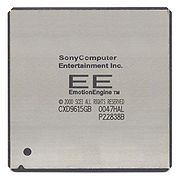

- CPU: 64-bit/128-bit "Emotion Engine" clocked at 294 MHz (299 MHz on newer versions), 10.5 million transistors
- System Memory: 32 MB(32 × 220 bytes) Direct Rambus or RDRAM
- Memory bus Bandwidth: 3.2 gigabytes per second
- Main processor: MIPS R5900 CPU core, 64 bit
- Coprocessor: FPU (Floating Point Multiply Accumulator × 1, Floating Point Divider × 1)
- Vector Units: VU0 and VU1 (Floating Point Multiply Accumulator × 9, Floating Point Divider × 1), 128 bit, at 150 MHz.
- VU0 typically used for polygon transformations, physics and other gameplay type things
- VU1 typically used for polygon transformations, lighting and other visual based calculations
- Texture matrix able for 2 units (UV/ST)[31]
- Floating Point Performance: 6.2 gigaFLOPS (single precision 32-bit floating point)
- FPU 0.64 gigaFLOPS
- VU0 2.44 gigaFLOPS
- VU1 3.08 gigaFLOPS (with Internal 0.64 gigaFLOP EFU)
- 3D CG Geometric transformation(VU0+VU1 parallel): 66 million polygons per second
- 3D CG Geometric transformations under curved surfaces: 16 million polygons per second
- 3D CG Geometric transformations at peak bones/movements/effects(textures)/lights(VU0+VU1): 15-20 million polygons per second (dependent on if series or parallel T&L)
- Actual real-world polygons (per frame):500-650k at 30fps, 250-325k at 60fps
- Compressed Image Decoder: MPEG-2
- I/O Processor interconnection: Remote Procedure Call over a serial link, DMA controller for bulk transfer
- Cache memory: Instruction: 16 KB(16 × 210 bytes), Data: 8 KB + 16 KB (ScrP)
- Graphics processing unit: "Graphics Synthesizer" clocked at 147 MHz
- Pixel pipelines: 16
- Video output resolution: variable from 256x224 to 1280x1024 pixels
- 4 MB (4 × 220 bytes) Embedded DRAM video memory bandwidth at 48 gigabytes per second (main system 32 MB can be dedicated into VRAM for off-screen materials)
- Texture buffer bandwidth: 9.6 GB/s
- Frame buffer bandwidth: 38.4 GB/s
- DRAM Bus width: 2560-bit (composed of three independent buses: 1024-bit write, 1024-bit read, 512-bit read/write)
- Pixel Configuration: RGB: Alpha:Z Buffer (24:8, 15:1 for RGB, 16, 24, or 32-bit Z buffer)
- Dedicated connection to: Main CPU and VU1
- Overall Pixel fillrate: 16x147 = 2.352 Gpixel/s (rounded to 2.4 Gpixel/s)
- Pixel fillrate: with no texture, flat shaded 2.4(75,000,000 32pixel raster triangles)
- Pixel fillrate: with 1 full texture(Diffuse Map), Gouraud shaded 1.2 (37,750,000 32-bit pixel raster triangles)
- Pixel fillrate: with 2 full textures(Diffuse map + specular or alpha or other), Gouraud shaded 0.6 (18,750,000 32-bit pixel raster triangles)
- GS effects: AAx2 (poly sorting required)[32], Bilinear, Trilinear, Multi-pass, Palletizing (4-bit = 6:1 ratio, 8-bit = 4:1)
- Multi-pass rendering ability
- Audio: "SPU1+SPU2" (SPU1 is actually the CPU clocked at 8 MHz)
- Number of voices: 48 hardware channels of ADPCM on SPU2 plus software-mixed channels
- Sampling Frequency: 44.1 kHz or 48 kHz (selectable)
- Output: Dolby Digital 5.1 Surround sound, DTS (Full motion video only), later games achieved analog 5.1 surround during gameplay through Dolby Pro Logic II
- I/O Processor
- CPU Core: Original PlayStation CPU (MIPS R3000A clocked at 33.8688 MHz or 37.5 MHz)
- Sub Bus: 32 Bit
- Connection to: SPU and CD/DVD controller.
- Interface Types:
- 2 proprietary PlayStation controller ports (250 kHz clock for PS1 and 500 kHz for PS2 controllers)
- 2 proprietary Memory Card slots using MagicGate encryption (250 kHz for PS1 cards, up to 2 MHz for PS2 cards)
- Expansion Bay (PCMCIA on early models for PCMCIA Network Adaptor and External Hard Disk Drive) DEV9 port for Network Adaptor
- Modem and Internal Hard Disk Drive
- IEEE 1394 (only in SCPH 10xxx – 3xxxx)
- Infrared remote control port (SCPH 5000x and newer) — IEEE 1394 port removed and Infrared port added in SCPH-50000 and later hardware versions.
- 2 USB 1.1 ports with an OHCI-compatible controller.
- Disc Drive type: 24x (PlayStation 2 format CD-ROM, PlayStation format CD-ROM), 4x (Supported DVD formats) — Region-locked with anti-copy protection. Can't read "Gold Discs" i.e., normal CD-ROMs.
- Supported Disc Media: PlayStation 2 format CD-ROM, PlayStation format CD-ROM, Compact Disc Audio, PlayStation 2 format DVD-ROM (4.7 GB), DVD Video (4.7 GB). Later models are DVD-9 (8.5 GB Dual-Layer), DVD+RW, and DVD-RW compatible.

